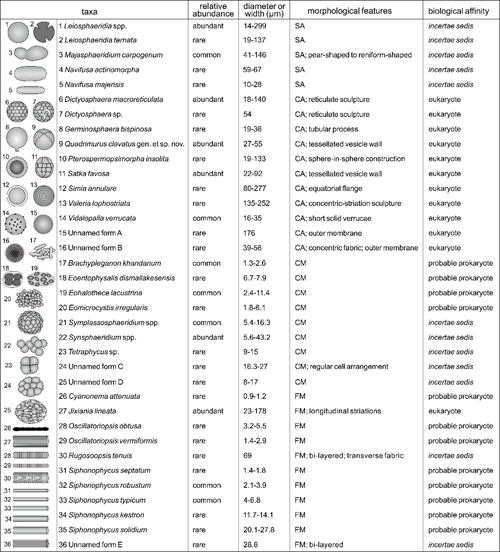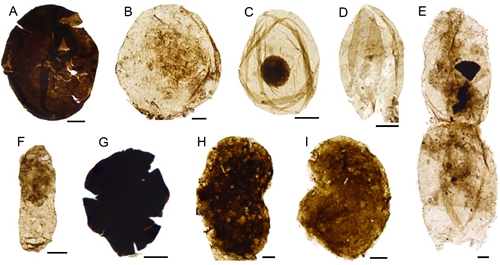The mid-Proterozoic (1.85-0.85 Ga) is a critical time for early evolution of eukaryotic organisms. However, this interval has often been referred as the "Boring Billion", new fossil records will provide some new ideas and basis for the dilemma about the Boring Billion.
In North China, the Yanshan area represents one of the few geological sites in the world having mid-Proterozoic sedimentary successions with preservation of excellent fossil records, e.g. the oldest eukaryotic fossils recovered from the lower Changcheng Group (ca.1.67~1.63 Ga) (Miao et al., 2019, Precambrian Research), multicellular eukaryotic macrofossils from the Gaoyuzhuang Formation (ca.1.56 Ga) (Zhu et al., 2016, Nature Communications).
Recently, an international research group led by Prof. ZHU Maoyan from the Nanjing Institute of Geology and Palaeontology, Chinese Academy of Sciences (NIGPAS) reports a diverse organic-walled microfossil (OWM) assemblage from the shale-dominated Mesoproterozoic Xiamaling Formation (ca. 1.4-1.35 Ga) in the Yanshan area. The study has been recently published on the international academic journal Precambrian Research.
The well-preserved OWMs in the assemblage are classified into 36 form species belonging to 28 genera, including 1 new species and 5 unnamed taxa, consisting of various individual vesicles, filamentous microfossils and cellular aggregates (or colonial microfossils). Prof. ZHU says, "most of these taxa are reported for the first time in the Xiamaling Formation".
Among them, the researchers inferred 12 taxa with eukaryotic affinity on the basis of the combined characteristics of complex morphology and large cell size. These eukaryotic fossils are predominately spheroidal vesicles with micron-scale surface ornamentations or sculptures (e.g. tubular process, reticulate sculpture, concentric striations, verrucae, outer membrane, equatorial flange), and spheroidal to ellipsoidal vesicles with complex wall structure (e.g. tessellated wall, double-wall construction), and one large tubular taxon Jixiania lineata with longitudinal equidistant striations.
According to the researchers, the fossil assemblage shows a moderate eukaryotic diversity which is similar to other contemporaneous OWMs worldwide, demonstrating that the prokaryotes may have still dominated the Mesoproterozoic ecosystems, but eukaryotic life had shown a certain degree of diversification during the Earth's middle age.
In addition, Jixiania lineata represents the only taxon in the Xiamaling assemblage with relatively short stratigraphic range, and has been reported from several early Mesoproterozoic successions in Australia, Siberia and Laurentia. The recognition of Jixiania lineata in North China expands its geographic distribution and further enhances its potential as index fossil for early Mesoproterozoic strata.
This work was supported by the National Natural Science Foundation of China and the Strategic Priority Research Program (B) of the Chinese Academy of Sciences.
Reference: Miao, L., Moczydlowska, M., Zhu, M., 2021. A diverse organic-walled microfossil assemblage from the Mesoproterozoic Xiamaling Formation, North China. Precambrian Research 360, 106235. https://doi.org/10.1016/j.precamres.2021.106235

Fig 1. Taxonomic compositions of the Xiamaling assemblage from the lowermost Xiamaling Formation.

Fig2. Simple vesicles of uncertain biological affinity from the Xiamaling assemblage.

Fig 3. Various cellular aggregates from the Xiamaling assemblage.

Fig 4. A broad stratigraphic range of organic-walled microfossils in the mid-Proterozoic.
Contact: LIU Yun, Propagandist
Email: yunliu@nigpas.ac.cn
Nanjing Institute of Geology and Palaeontology, Chinese Academy of Sciences
Nanjing, Jiangsu 210008, China
